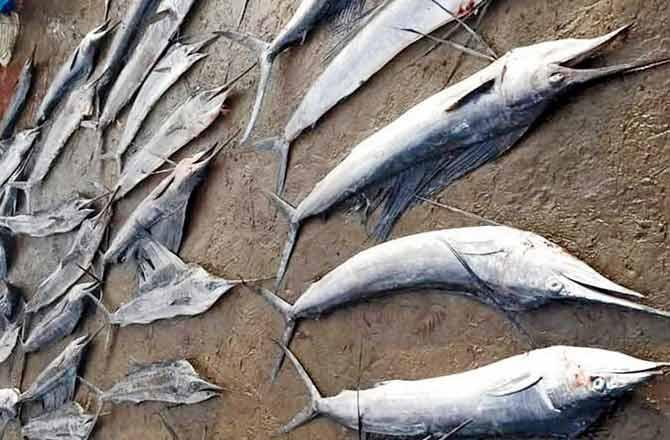A village that once sent back tourists with box full of local catch, is struggling to meet demand. Experts say it's time consumers, fishermen and government kept its greed in check

Sting ray fish, up for auction at the Harnai port
At 4 pm every day, the fish market at the Harnai beach in Ratnagiri gets buzzing. Fresh catch from the trawlers gets unloaded and bullock carts ferry it to the spot where an auction is unfolding. Kilos of pomfret, kingfish, mackerel, jumbo prawn, lobster, squid, sting ray are sold in bulk, and transported to Mumbai and other cities.
ADVERTISEMENT
It's a bargain. The catch is fresh and cheap, almost one-fourth the price of what you pay in Mumbai. The year-end sees plenty of tourists from Mumbai and Pune flocking the scene and packing ice-box full of seafood to take home.
A mechnaised trawler is equipped to go deeper in the sea and expected to bring back plenty of catch
However, according to locals, many returned home disappointed last year. There was not enough fish in the sea.
Harnai in Ratnagiri district of Maharashtra, with its 1,200 boats, is one of the only few ports in the country that follows sustainable fishing practices. The waters in the Dabhol-Harnai belt have forever been abundant with marine life, but the last three years have been difficult for the local fisherfolk on the Konkan coast.
Harnai, a historic port with 1,200 boats still practices sustainable techniques for fishing
Mubeen Harge, Chairman, Swarnadurga Fishing Co-operative Society in Harnai, tells mid-day, "The cyclones on the West coast, especially Nisarg last year, created great havoc and affected us deeply. In addition, across the Western coast, including the shores of Goa, Karnataka and Kerala, LED fishing is being done. Fish are attracted by holding a light above water or suspending it below water. Fish are then caught using nets in large quantities. This has led to a depletion of supplies because juvenile fish are killed. It has become a sustainability issue."
Aslam Khan, former chairman of the society highlights the overfishing of sardines, which are food for other fish, as another problem. The fishermen of Harnai had organised protests at Azad Maidan and Sassoon Dock three years ago to highlight the issue. Khan believes it's not long before fishermen too fall prey to suicides due to pressures their traditional occupation is facing. Loans are now also tougher to come by. "Previously, the National Cooperative Development Corporation (NCDC) used to give us 75 per cent loan and 25 per cent came from the government. Since 2016, NCDC has stopped the loans. Our boats are in bad shape and need repairs."
Mubeen Harge, Chairman, Swarnadurga Fishing Co-operative Society
Explaining the math behind a fishing trip, Harnai local Azim Sarang says that while previously, the cycle for trawlers was two to three days, now, it's between eight to 15 days. One trip takes four barrels of diesel, each costing R20,500. Add to it the cost for ice and seven member labour. "They don't return unless they feel they have enough return on investment, which is more than a lakh per trip."
Alissa Barnes is an independent marine biologist specialising in shark and ray fisheries. She explains that fish missing from the sea cannot be an overnight phenomenon. Rapid declines have occurred over the last 50 years, especially after trawl nets were introduced in the 1960s along the east and west coasts to harvest shrimp. This was aided, she says, by the Food and Agriculture organisation (FAO) and the Indo-Norwegian project. However, the last five years have been especially hard, considering major climate change. And the pandemic only made matters worse."
Back with a catch: The fuel, labour and provision cost for a trawller runs into lakhs
It looks like a vicious cycle then, with multiple factors, including recent cyclones along the west coast, causing chaos in the marine ecosystem. Unhealthy fishing behaviour, including increased soak time (duration where the net is set/dragged under water) and number of times nets are set, leads to decreased availability. The fishing grounds then move further away into open waters, leading to fishermen using bigger boats and higher horse power engines. And if bottom-trawl gear is used, it destroys the seabed.
Concrete reclamation in the coastal road has done more harm than good for fishing. It's a recipe that'll destroy what Sarita Fernandes, managing trustee, Morjim Sea Turtle Trust and Capan Seas, calls the peace of the coastal zone. Tide diversion and shifting of tidal boundaries lead to complications because these zones are also the breeding ground for economical catch like lobster, prawn and deep sea pelagic fish.
Azim Sarang, Aslam Khan and Alissa Barnes
Barnes feels, a good place to start is to be mindful of what fish you eat. She says, "Eat local. If you have access to spaces where fishermen land/sell/buy fish, talk to them, ask them about different varieties they catch. On a larger scale, policy change is a must, but the idea should be to find customisable solutions for each region. Australia and the US are good models to look at for laws and management plans although copy pasting plans never works. It's always prudent to involve the fishing community in policy changes since it affects their livelihood."
'Seafood is not chicken'
Divya Karnad, Assistant Professor, Ashoka University and Co-founder, InSeason Fish
"We cannot treat seafood as if it is the same as chicken. Seafood includes hundreds of species. Eating diverse is the key to a healthy life and healthy oceans. At InSeason Fish, we promote eating diverse through our seafood calendar, (available on the website www.inseasonfish.com) which helps you choose when to sustainably eat 100 varieties. We have also done research on recipes for the unusual varieties and feature them on our social media page."
 Subscribe today by clicking the link and stay updated with the latest news!" Click here!
Subscribe today by clicking the link and stay updated with the latest news!" Click here!






